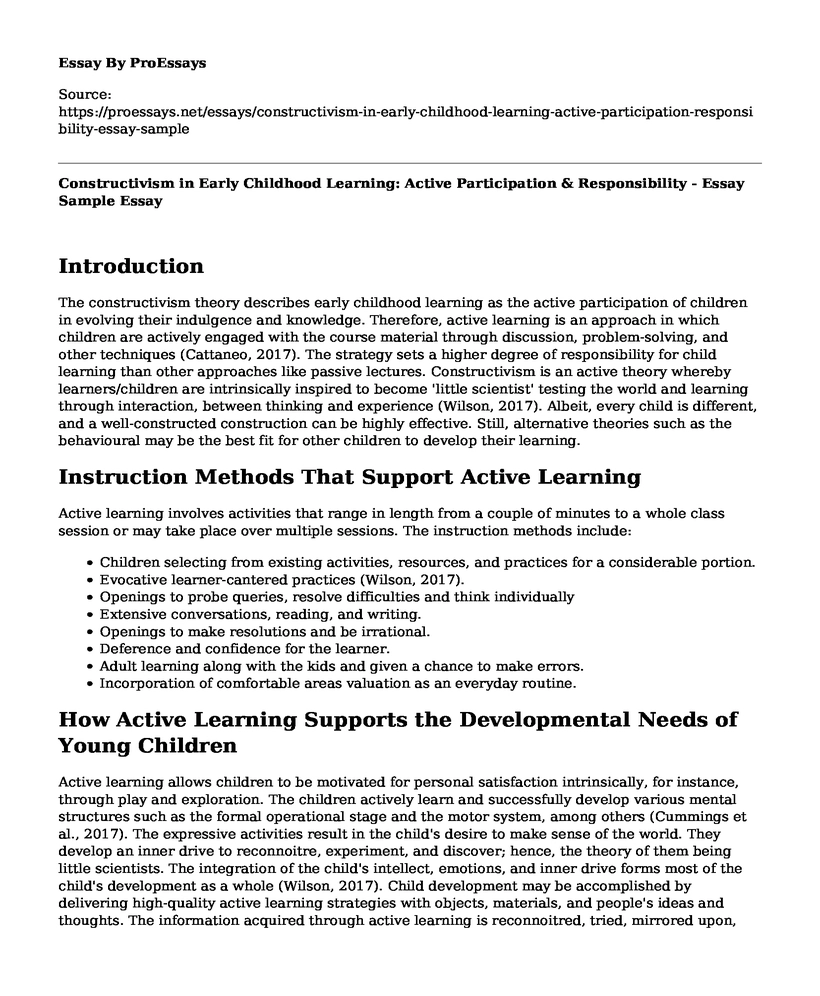Introduction
The constructivism theory describes early childhood learning as the active participation of children in evolving their indulgence and knowledge. Therefore, active learning is an approach in which children are actively engaged with the course material through discussion, problem-solving, and other techniques (Cattaneo, 2017). The strategy sets a higher degree of responsibility for child learning than other approaches like passive lectures. Constructivism is an active theory whereby learners/children are intrinsically inspired to become 'little scientist' testing the world and learning through interaction, between thinking and experience (Wilson, 2017). Albeit, every child is different, and a well-constructed construction can be highly effective. Still, alternative theories such as the behavioural may be the best fit for other children to develop their learning.
Instruction Methods That Support Active Learning
Active learning involves activities that range in length from a couple of minutes to a whole class session or may take place over multiple sessions. The instruction methods include:
- Children selecting from existing activities, resources, and practices for a considerable portion.
- Evocative learner-cantered practices (Wilson, 2017).
- Openings to probe queries, resolve difficulties and think individually
- Extensive conversations, reading, and writing.
- Openings to make resolutions and be irrational.
- Deference and confidence for the learner.
- Adult learning along with the kids and given a chance to make errors.
- Incorporation of comfortable areas valuation as an everyday routine.
How Active Learning Supports the Developmental Needs of Young Children
Active learning allows children to be motivated for personal satisfaction intrinsically, for instance, through play and exploration. The children actively learn and successfully develop various mental structures such as the formal operational stage and the motor system, among others (Cummings et al., 2017). The expressive activities result in the child's desire to make sense of the world. They develop an inner drive to reconnoitre, experiment, and discover; hence, the theory of them being little scientists. The integration of the child's intellect, emotions, and inner drive forms most of the child's development as a whole (Wilson, 2017). Child development may be accomplished by delivering high-quality active learning strategies with objects, materials, and people's ideas and thoughts. The information acquired through active learning is reconnoitred, tried, mirrored upon, and epitomized in various ways.
Through constructivism, children learn to use resources to make a specific product representing ideas or processes such as painting, drawings, and three-dimensional creations (Wilson, 2017). Besides, children learn to interrelate with their vibrant environment provided by their teachers, augmenting their experience, which is designed to nurture their intellectual development. Active learning improves a child's mental and linguistic growth by boosting the vibrant potentials within a dialogue associated with the child's lively involvement in significant, developmentally applicable learning practices (Cattaneo, 2017). Besides, an active social environment allows the child to develop communication skills by modelling their caring.
References
Cattaneo, K. H. (2017). Telling active learning pedagogies apart: From theory to practice. Journal of New Approaches in Educational Research (NAER Journal), 6(2), 144-152.
Cummings, C., Mason, D., Shelton, K., & Baur, K. (2017). Active learning strategies for online and blended learning environments. In Flipped Instruction: Breakthroughs in Research and Practice (pp. 88-114). IGI Global.
Wilson, B. G. (2017). Constructivism for active, authentic learning. Trends and issues in instructional design and technology, 61.
Cite this page
Constructivism in Early Childhood Learning: Active Participation & Responsibility - Essay Sample. (2023, Aug 23). Retrieved from https://proessays.net/essays/constructivism-in-early-childhood-learning-active-participation-responsibility-essay-sample
If you are the original author of this essay and no longer wish to have it published on the ProEssays website, please click below to request its removal:
- Reflections on How I Learned
- Introduction of Myself to Get Scholarship in Delaware County Community College
- Experience From Your Life That Changed the Way You Think Essay
- Managing Classroom Challenges Paper Example
- Childhood Trauma: Examining African-Americans' Participation in NCAA Division One Sports - Research Paper
- Essay Sample on College Degree: Essential for Successful Career & Adult Life
- Paper Example on Understanding Williams Syndrome: Causes, Symptoms & Treatment







